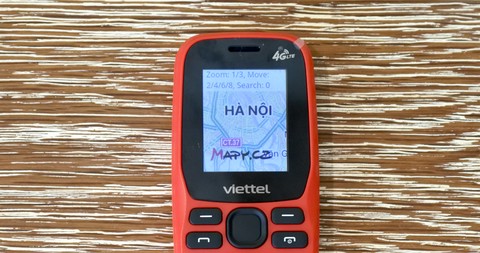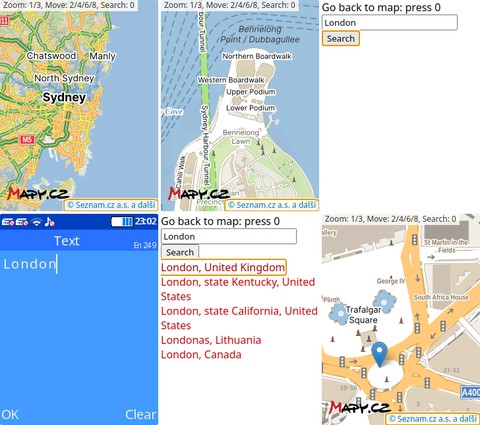
Out of nostalgia and curiosity, Tomas Tauber bought the rebooted Nokia 3210 4G. Tomas found “satisfaction and delight in using the iconic Nokia 3210 again,” that ultimately led him to develop the first Maps app.
Cloud Phone allowed me to easily extend a feature phone’s functionality without flashing its firmware and using the modern web browser engine. I wanted to try it out for some features I was missing on the original 3210.
Why Maps?
Google Maps is the app I miss the most on feature phones. I tried running it on Cloud Phone, and it almost worked: the map loaded and the keypad-based controls worked. However, it had two major flaws that prevented me from using it.
- It used the Cloud Phone’s server IP to determine the initial map position, which wasn’t helpful since I wasn’t in Singapore.
- I could type in the address search bar, but I couldn’t select to display the address on a map.
How Maps was built
Noticing these issues, Tomas decided to build the first Maps app specifically for Cloud Phone using vanilla JavaScript and Rust on the backend. The first prototypes used the Mapbox GL JS-derived libraries (backed by WebGL), but encountered issues that have been resolved in more recent Cloud Phone server updates.
Although Cloud Phone already supports quite a lot of features, it’s frustrating, “that many devices, including my 3210 4G, are stuck on older Cloud Phone versions.” This includes features like file upload and camera access, which are not available on the 3210 4G.
Update challenges
For the future, some form of client “auto-update” without going through the manufacturer’s OTA would be great. That way, just like on the server side, we could know Cloud Phone is running a pretty recent Chrome browser engine and rely on “client-side” features of recent Cloud Phone versions more.
Developer opportunities
Tomas expressed that, “there are so many ideas in my head,” and shared his wishlist for other developers who might want to collaborate or sponsor his efforts.
Communication and messaging
Rich Communication Services (RCS) is gaining popularity, and Cloud Phone could bridge messaging protocols over the web. “I would like to give a big shout out to the TeleKram project”, an unofficial Telegram client.
However, “many proprietary protocols are actively hostile to third-party clients.” There are opportunities for open protocols like XMPP, Matrix, or IRC, all of which have functioning web clients. Tomas also mentioned email apps as another valuable communication channel. JMAP is a, “developer-friendly, open API standard for modern mail apps,” with web support. However, its adoption is limited beyond Fastmail. A Cloud Phone email app would need to connect over the legacy IMAP and SMTP protocols, likely via a proxy server.
Utilities
Other nice-to-haves include AI chatbots, a calendar app for reminders, and a QR code scanner that stores tickets and cards in a digital wallet. Although they aren’t as essential as communication apps, they simplify common tasks and are needed by users every day.
Payments
In India, many devices including the Nokia 3210 come with UPI (via the GSPay app) pre-installed. Similarly, Cloud Phone could allowing users to make micropayments for goods and services. This includes integration with local payment methods like UPI in India or M-Pesa in African countries.
Building apps that work globally across many countries is challenging. Although cryptocurrency wallets theoretically work globally, it would be a significant undertaking with several challenges including high transaction fees, a complex on-ramp, and UI/UX difficulties.
Games
Cloud Phone already has a catalog of games. However, “back in the J2ME days, there were many great games.” Many web-based HTML5 games will work on Cloud Phone, and even some native games like Doom should be possible using WASM.
Collaborate
If you’d like to collaborate with or sponsor Tomas’ work, reach out at .
Developer tips
Tomas offers some advice to aspiring Cloud Phone developers. “QQVGA is the most challenging resolution to optimize for.” Use the Cloud Phone templates available for different JS and CSS frameworks to get started. Tomas also uses Chrome’s Device Mode for quick iteration, and the Cloud Phone Simulator (even if you have a feature phone to test on). Last, join the Cloud Phone Discord server for further assistance.
Summary

Cloud Phone is an emerging and rapidly-growing platform to run web apps on feature phones. Tomas was among its earliest adopters, writing about Cloud Phone and other remote browsers back in July 2024. Maps was Tomas’ first Cloud Phone widget, published in September 2024, followed by Notes two months later.
Contact Us
Contact Cloud Phone to learn how you can make services product like Maps available on feature phones around the world
Get Support